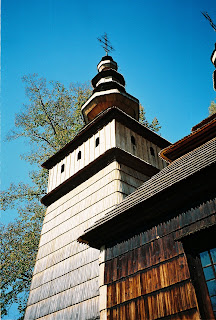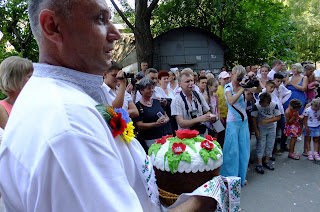The Outbacks
Do you remember this feeling when you are a kid and you play treasure quest in your grandma's attic? Well, this is how I feel discovering the culture of the people called Lemkos.
In the south east of Poland where I used to spend any given school holiday, this ethnic group have established a flourishing culture. They have been shepherds who migrated from the territory of today Romania. They came in the 13th century to the Subcarpathian Region, they were orthodox. Partially they preserved their own specific culture however they adapted as well to the multicultural society of this part of Europe. For example, they took over influences from the western christianity, among these the architecture.
In the vain of wars, nationalistic movements and in course of stalinist regime this entire ethnic group has been dislocated in many different geographical directions - some had to flee to the USSR being originally and now again Ukrainian territory, some of them have been dislocated in course of the so called operation Vistula to the new Polish territories that after World War II have been attached to Polish state in the West. The dislocation was so absolute that it meant a complete abandonment of villages, property and sacral buildings. Nobody was allowed to talk about any ethnic groups within state territories in stalinist and post stalinist communist times. No mentioning in history books was thinkable.
As a child I used to hear scratches of the allusions adults have made in their conversations when we were sitting in the Carpathian mountains around the fire place. The topic was secret and nobody really was able to precisely describe what happened here. But here is a story: our friends have a house where we went each year to spend a part of our vacations. The house stands at a lake in Bieszczady (a part of Carpathian mountains). The lake belongs to a generating plant owned by the state. This is a dam lake. The landscape is there original and reminds you of Wild West or at least of what you think you know about it. Our friends who used to go to the lake in the time they were still in school and also afterwards in their university time, they fished the house out of the lake one day. The were paddling on the lake and all of a sudden they saw something underneath the surface. When they got close they realized it was a house - one of the many which were flooded when communists have built a dam and covered with water entire abandoned villages. They took the house out of the water and reconstructed it on the shore of the lake and own it as their holiday house till today.
Similarly to this house, cultures who have been flooded by totalitarianism of the 20th century now come up to light - people start to talk about what they can still find here and there in the landscape.
So there is the path of wooden architecture in the South of Poland. One of the most amazing objects to see there are wooden churches built by the Lemko culture. They have been built out of wood not because stone as material was not available. They have been built out of wood because according to the architects wood was equally good to construct a beautiful object of sacral art. They took example on western sacral art but their churches were still orthodox. After the people have been scattered in all directions, the buildings have been left, have been closed for decades, at some point, when they were lucky enough, they went over to the Catholic church so the local communities could take care of them. Many have been destroyed on purpose however, many underwent a slow decay. After the transition of political system, Polish conservators managed to raise money and save many of these architectonical objects. You can visit them now if you decide to take a detour from the major tourist tracks. These churches on the pictures below are situated not far away from each other, in the region of Jaslo and Gorlice.
So, discovering the wooden architecture of Lemko culture is making me as crazy as I used to be when my cousin and me were looking for treasures in the attic of the house of our parents and grand parents in Jaslo. It is all covered by history and it is all in the dark but you know, somewhere on the bottom there are jewels to be found.
And just recently I was able to talk to the first Lemko in my life who publicly admitted coming from the region: it was the psycho bus driver in the Ukraine, who has given me a certain indifference towards a death in a car crash. Another Lemko, whose name might be familiar to you is Andy Warhol.
Enjoy the pictures which all have been taken in September 2006, when another psycho driver took my family and me for this great day trip.
Church in Kotan

 Skwirtne
Skwirtne
Kwiaton
 Swiatkowa Mala
Swiatkowa Mala
 Swiatkowa Wielka
Swiatkowa Wielka
 Krempna
Krempna




















































